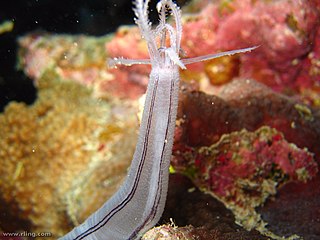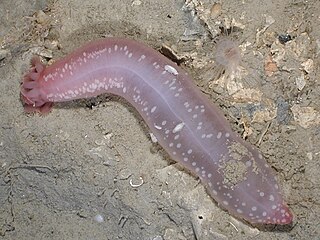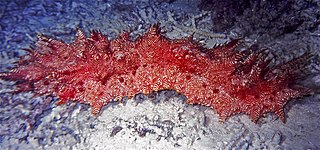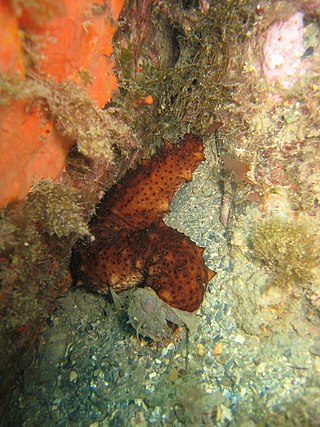
Sea cucumbers are echinoderms from the class Holothuroidea. They are marine animals with a leathery skin and an elongated body containing a single, branched gonad. They are found on the sea floor worldwide. The number of known holothurian species worldwide is about 1,786, with the greatest number being in the Asia-Pacific region. Many of these are gathered for human consumption and some species are cultivated in aquaculture systems. The harvested product is variously referred to as trepang, namako, bêche-de-mer, or balate. Sea cucumbers serve a useful role in the marine ecosystem as they help recycle nutrients, breaking down detritus and other organic matter, after which bacteria can continue the decomposition process.
Evisceration is a method of autotomy involving the ejection of internal organs used by animals as a defensive strategy. Sea cucumbers (Holothuroidea) eject parts of the gut in order to scare and defend against potential predators such as crabs and fish. The organs are regenerated in a few days by cells in the interior of the sea cucumber.

Scotoplanes is a genus of deep-sea sea cucumbers of the family Elpidiidae. Its species are commonly known as sea pigs.

The orange-footed sea cucumber is the largest sea cucumber in New England, United States. It is one of the most abundant and widespread species of holothurians within the North Atlantic Ocean and the Barents Sea (Russia), being most abundant along the eastern coast of North America.

Enypniastes is a genus of deep-sea sea cucumber. It is monotypic, being represented by the single species Enypniastes eximia. Due to its unique appearance, the species has been dubbed the headless chicken fish, headless chicken monster, and the Spanish dancer. It is also known as the swimming sea cucumber, and some are called the pink see-through fantasia.

Elasipodida is an order of sea cucumbers. They have numerous appendages, including conical papillae and leaf-like tentacles. Although many species are benthic, a number are pelagic, and may have their appendages modified to form sails or fins. Most members of the order inhabit deep-sea environments, such as the species of the genus Enypniastes.

Psychropotes is a genus of sea cucumbers in the family Psychropotidae. The members of this genus possess the ability to swim, although this is only facultative.

Psychropotes longicauda is a species of sea cucumber in the family Psychropotidae. It inhabits the deep sea where the adult is found on the seabed. The larva is pelagic and has an appendage shaped like a sail on its back which may enable it to move through the water.

Synaptula lamperti is a species of sea cucumber in the family Synaptidae in the phylum Echinodermata, found on coral reefs in the Indo-Pacific region. The echinoderms are marine invertebrates and include the sea urchins, starfish and sea cucumbers. They are radially symmetric and have a water vascular system that operates by hydrostatic pressure, enabling them to move around by use of many suckers known as tube feet. Sea cucumbers are usually leathery, gherkin-shaped animals with a cluster of short tentacles at one end. They live on the sea bottom.

Holothuria scabra, or sandfish, is a species of sea cucumber in the family Holothuriidae. It was placed in the subgenus Metriatyla by Rowe in 1969 and is the type species of the subgenus. Sandfish are harvested and processed into "beche-de-mer" and eaten in China and other Pacific coastal communities.

Colochirus robustus, commonly known as the robust sea cucumber or the yellow sea cucumber, is a species of sea cucumber in the family Cucumariidae. It is found in shallow seas in tropical parts of the central Indo-Pacific region. C. robustus belongs to the class Holothuroidea, a group of echinoderms called sea cucumbers and known for unusual behavior including evisceration, asexual reproduction, and regeneration. The robust sea cucumber has a soft body and lacks a spine, but it does have an endoskeleton consisting of microscopic spicules, or ossicles, made of calcium carbonate. C. robustus has a respiratory tree that allows it to extract oxygen for respiration, using the anus to pump water. The robust sea cucumber is an important dietary staple for many East and Southeast Asian populations, and has been used for medicinal purposes for hundreds of years. Recent research suggests that peptides from C. robustus enhance the activity of the immune system.

Pelagothuria is a genus of sea cucumbers in the family Pelagothuriidae. It is monotypic, being represented by the single species Pelagothuria natatrix.

Chiridotidae is a family of sea cucumbers found in the order Apodida. Within the family, there are 16 recognized genera all with different ranges of body types and functions. Sea cucumbers play a fundamental role in many marine ecosystems.
Leptosynapta dolabrifera, the snot sea cucumber, is a small sea cucumber under the class Holothuroidea (1), in the family Synaptidae. It is most closely related to another species in its genus of 34 species Leptosynapta known as Leptosynapta inhaerens.

Thelenota rubralineata is a species of sea cucumber in the family Stichopodidae, in the phylum Echinodermata, mainly located in the central Indo-Pacific region. It has a distinctive coloring pattern, and can be found on the seabed near coral. T. rubralineata is a member of the Thelenota genus, characterized by their large size and the presence of a calcareous ring.

Pawsonia saxicola, the sea gherkin, is a species of sea cucumber in the family Cucumariidae. It is found in the northeastern Atlantic Ocean and the Mediterranean Sea.

Thyone fusus is a species of sea cucumber in the family Phyllophoridae. It is found on the seabed in the northeastern Atlantic Ocean and the Mediterranean Sea. It is a suspension feeder and catches food particles floating past with its branching feeding tentacles.

Cucumaria vegae, also known as tiny black sea cucumber or northern tar spot, is a species of sea cucumber. It was first described to science by Johan Hjalmar Théel in 1886 reporting on the sea cucumber specimens brought back by the Challenger expedition. Among these was the type specimen for this species, which was collected at Bering Island.

Benthodytes is a genus of sea cucumbers in the family Psychropotidae.

Holothuria stellati, also known as the Brown sea cucumber,is a species of sea cucumber in the family Holothuriidae. First described by Delle Chiaje in 1824. There are two accepted subspecies, Holothuria stellatidakarensis and Holothuria stellati mammata, though there is still debate on whether or not they are separate species.

















